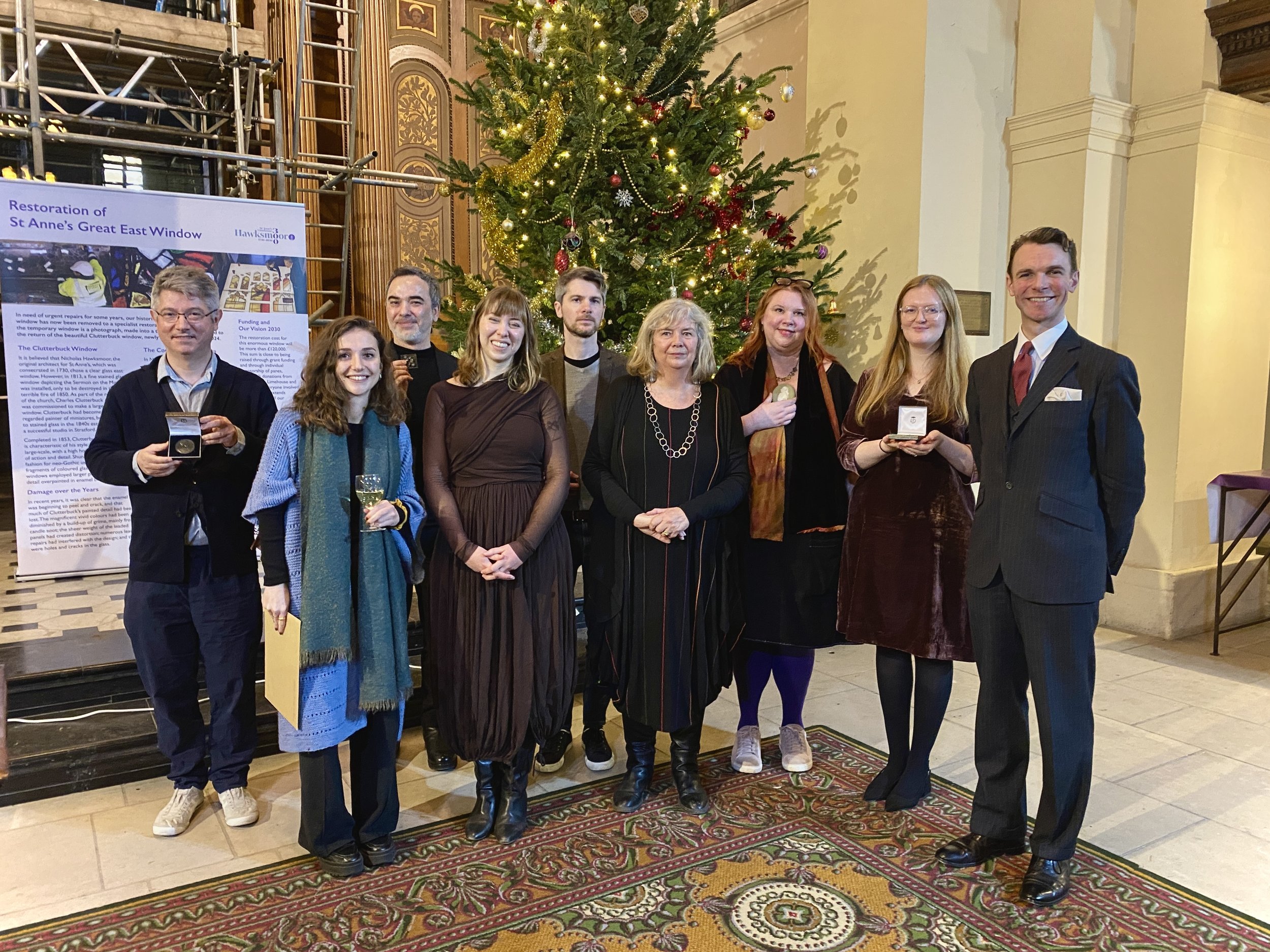The 2024 Annual Awards Ceremony
The 2024 annual Awards ceremony took place 6 December at the church of St Anne’s, Limehouse, one of Nicholas Hawksmoor’s six London churches. Now surrounded by development, including nearby Canary Wharf, when completed in 1730 this imposing structure was surrounded by open pasture. The church was built to serve the nearby maritime trades along the Thames, and it remains a designated maritime church. In the 1970s, John Betjeman wrote that St Anne’s was one of the ten buildings in England “for which I am prepared to go to the stake.” Though Grade 1 listed, the church remains on Historic England’s At Risk Register, with the interior visibly suffering from water ingress. Philip Reddaway, of Care for St Anne’s, spoke to us about current fundraising plans for a full restoration. The vision is for an accessible working church fully adapted to the future needs of its community and taking centre stage in the cultural life of Limehouse.
At St Anne’s Limehouse we were delighted to welcome the winners, panel members, and supporters to celebrate the 2024 awards for research and writing. Amidst drinks and conversation, attendees were able to explore this wonderful building before the official ceremony began. Current SAHGB president Elizabeth McKellar presided, presenting the Alice Davis Hitchcock Medallion, the Colvin Prize, the Hawksmoor Essay Medal, the Heritage Research Award, and the Dissertation Prize.
The Alice Davis Hitchcock Medallion has been awarded annually since 1959 to a monograph that makes an outstanding contribution to the study or knowledge of architectural history. This year the joint winners were: Robyne Calvert, The Mack: Charles Rennie Mackintosh and the Glasgow School of Art (Yale University Press); and Steven Brindle, Architecture in Britain and Ireland, 1530-1830 (Paul Mellon Centre).
The Colvin Prize is awarded annually to the author or authors of an outstanding work of reference of use and value to architectural historians and the discipline of architectural history across a range of formats. The winner this year was Hamed Khosravi, Do you remember how perfect everything was? The Work of Zoe Zenghelis (AA Publications).
The Hawksmoor Essay Prize is to encourage new and unpublished entrants to the field of architectural history, awarded annually to the author of the best essay submitted in competition. This year there were two commendations: Aleksander Musiał, The Pleasures of Antiqueereones: Speculative Antiquities and Rediscovering Hygiene Architecture in Charles Cameron’s Ancient Thermae Series (1767-1780); and Aoife Stables, The Art of Triumph: A Print of the Florentine Arch for the Royal Entry of Mary I into London, 1553. This year’s winner was Christopher Cowell, The Height of Health: Sections, Sanatoria, and Settler Colonialism in Northern India, 1815–1842.
The SAHGB-IHBC Heritage Research Award recognises and celebrates the quality of architectural-historical research produced by colleagues in heritage and conservation practice, as private consultants and in non-departmental public bodies. This year there were joint winners: Tim Howson, Market Cross, 25 Town Street, Thaxted, Essex (Heritage Asset Assessment, 2024); and Dr Christian Clarkson and Nicholas Uglow, Dalkeith Palace, Midlothian (entry draws on a recent Conservation Management Plan for the site).
The Dissertation Prize, awarded in two categories, celebrates the outstanding work in architectural history being carried out by postgraduate students on taught Masters-level courses in UK universities. Category 1 celebrates Dissertations written as part of a taught MA / MSc course in Architectural History, Heritage or Conservation. Category 2 honours dissertations submitted at MArch and MSc courses researching questions of architectural history as a broader field.
This year, for Category 1, there was a commendation for Kshiraja Krishnan, City of Limelight: The spatial production of cinema halls and late-colonial Bombay (1910-1933). The winner was Arielle Lavine, FOREST CHILDREN: How Educations of Indigenous and Settler Children Reinscribe the Colonial Order. For Category 2, the winner was Bianca Zucchelli, The Eel, The Dowry and The Seamstress.
More information on this year’s awards can be found on the SAHGB website, including the judges’ citations and an article by Philip Reddaway on St Anne’s Limehouse. The awards are overseen by the SAHGB to reward work that is innovative, ambitious and rigorous in tackling histories of the built environment as broadly conceived. The SAHGB’s awards programme is open and inclusive wherever possible, celebrating diversity of approach and recognising work at all career levels. Congratulations to this year’s recipients!

